UCLA’s Marion Anderson Hall gets down to business with multifunctional AV.
“The business of America is business” is the streamlined version of a somewhat more nuanced aphorism1 uttered by President Calvin Coolidge in 1925, but the business of how business is taught and learned in America is its own narrative. Even as undergraduate programs have struggled2 to keep classrooms full in the wake of the 2008 financial collapse, university MBA programs remain fiercely competitive, particularly as more women, who now make up nearly 40 percent of all MBA enrollments in the US, join the executive ranks. That’s led to a burst of new infrastructure in recent years to manage more robust and diverse academic programs, and to attract more tuition and alumni dollars. Substantial new complexes have been, or are being, built at a number of top business schools, including Haas, Columbia and Kellogg, all aimed at competing to attract the best and brightest students.
One of those is Marion Anderson Hall, a 64,000-square-foot, $40 million project designed by architectural firms Pei Cobb Freed & Partners and Gensler, the latter of which designed the structure’s active-learning classrooms, auditorium and workspaces, as well as its event and gathering spaces. All are intended to facilitate an “enhanced student lifecycle experience”—from admissions, to student affairs, to career support, to alumni connections. Part of the UCLA Anderson School of Management at the University of California at Los Angeles, the MBA program there is known for its emphasis on early specialization and it’s consistently ranked in the top 25 programs in the country. Now, Marion Anderson Hall is framed as the program’s “new front door,” the school’s blog said3. It is intended to alleviate space shortages from program expansions and student growth—the school’s academic centers have multiplied from three to the current eight, with a ninth on the way, serving a student population that is 64 percent larger than it was in 1995—and “geared to hybrid, flexible learning and equipped with infrastructure to support evolving classroom technologies.”
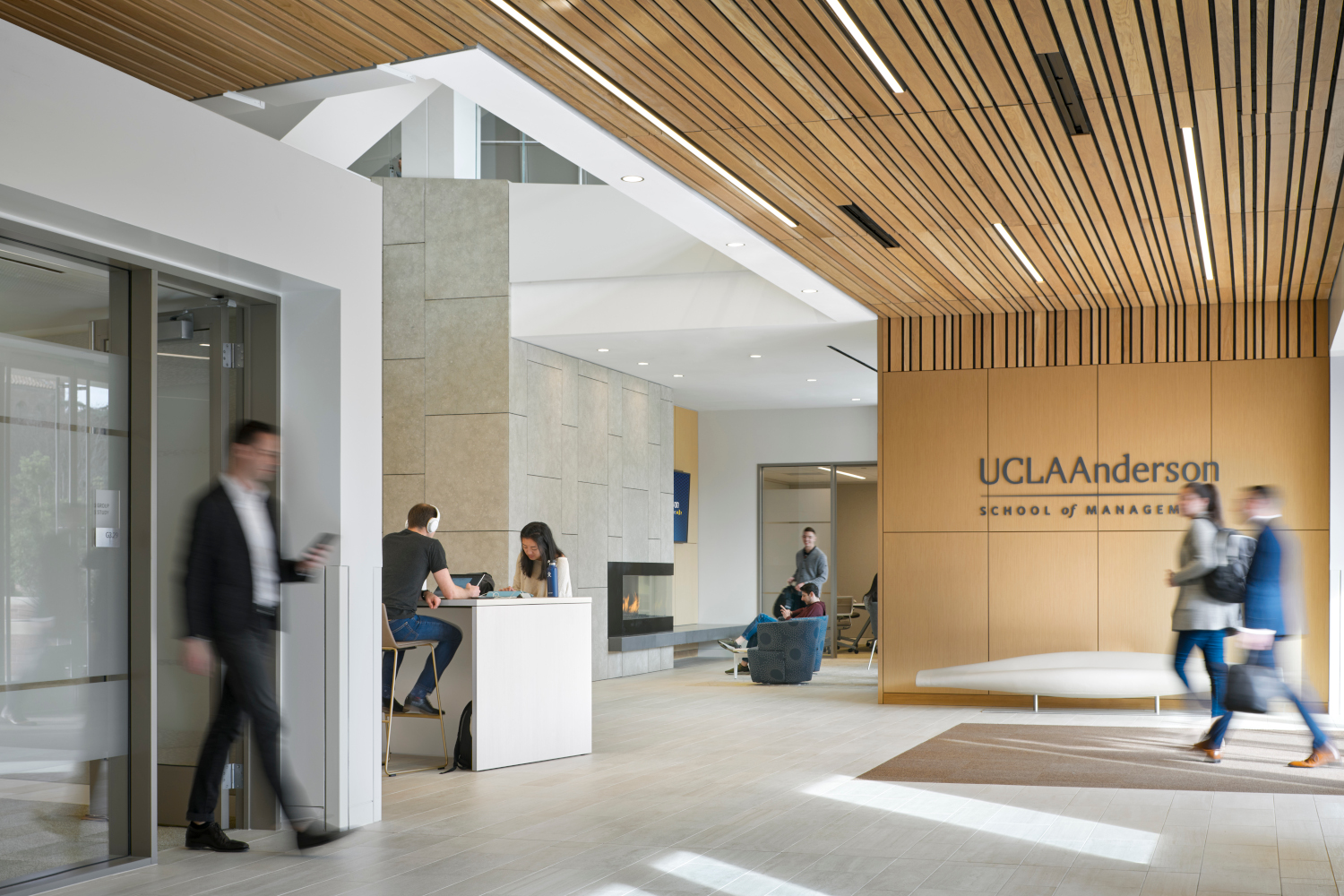
A Flexible Space
Marion Anderson Hall sprawls across four floors, encompassing a range of room types—from classrooms, to meeting spaces, to administrative offices, to several dozen small interview rooms. The last feature webcams and microphones used by students to do practice job interviews or to do actual ones. “The students here are largely people who are already in the corporate world, here to get their [MBA] degrees, so they’re already used to a certain level and type of technology in communications and business,” Michael Di Santo, a principal with Waveguide, the AV consultancy on the project, said. He’s also the director of Waveguide’s California operations. “The project’s AV needed to meet their expectations.” That included highly flexible active-learning classrooms in which sensor-guided cameras switch automatically to follow instructors as they move from whiteboard to whiteboard. It also meant that the AV implementation and integration also be aligned with the architects’ esthetic visions. In the case of the large event space, that meant making sure that audio was full range, steerable and highly intelligible, without interfering with the look of the space’s undulating tiled ceiling.
“The teaching rooms have a specific purpose, of course, but the main challenge here was the multifunctional nature of all of the rooms,” Thomas McNally, Waveguide’s senior consultant on the project, explained. “The event and active-learning spaces, as well as the meeting rooms and common areas, all needed to be very flexible. For instance, the instructors wanted to be able to teach from a lectern at the front of the room, a lectern in the middle of the room, or allow the students to break away into small independent groups using their own displays and cable cubbies in the active-learning classrooms. Also, all video content in the rooms needed to be able to route to all video endpoints in the room. That required a lot of different infrastructure.”
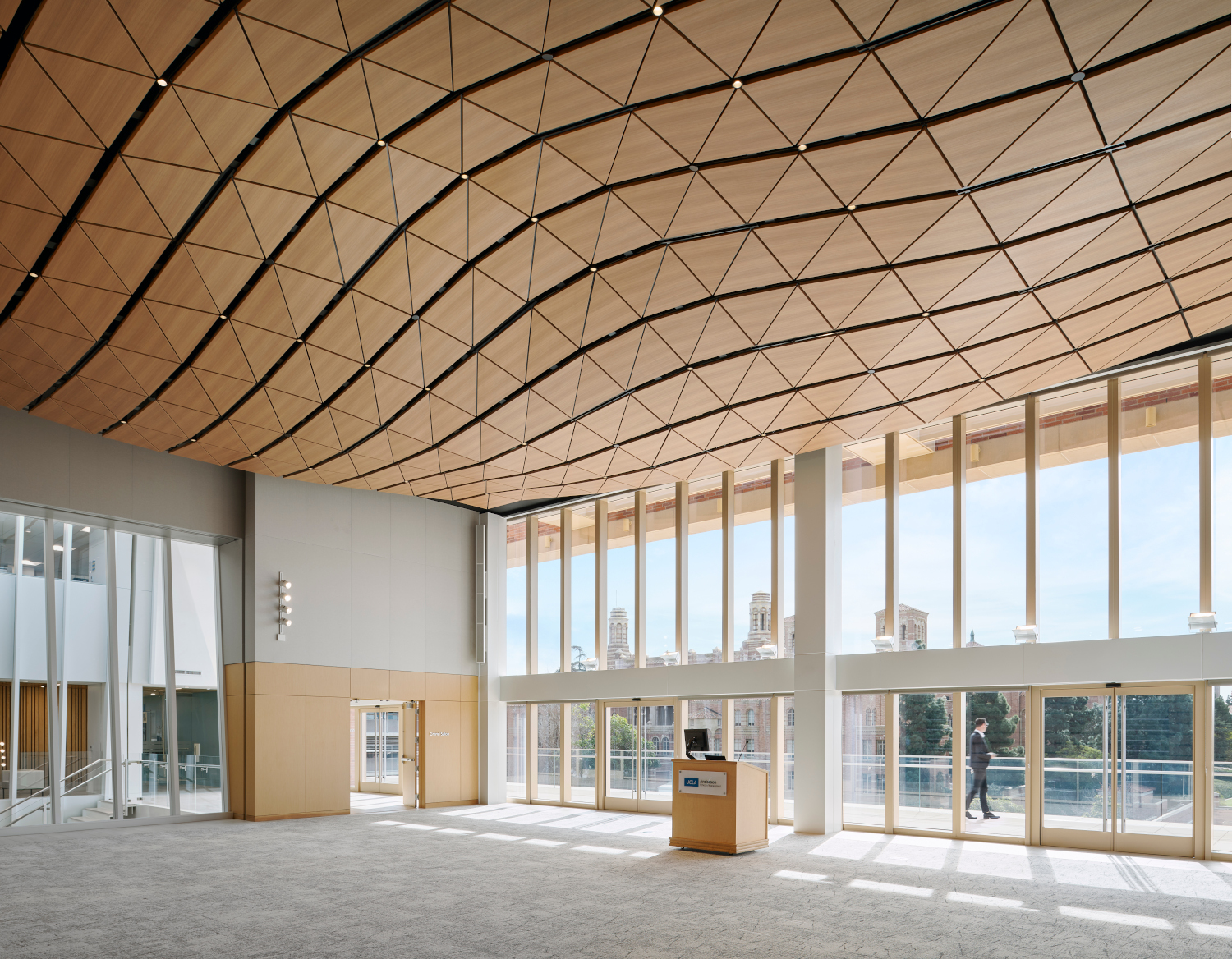
Actively Learning
The active-learning classrooms are technologically complex and sophisticated. LG 75-inch 4K displays line the side and rear walls while the connected lecterns, supplied by the school and which hold dual computer screens and basic room controls, are flanked by a pair of Da-Lite projection screens illuminated by Digital Projection M-Vision 18K laser projectors. A pair of Optex infrared sensors notice when the instructor moves between areas, such as the lectern and whiteboards, and signals the Crestron NVX control system to select between the two Panasonic PTZ cameras in each classroom. The active-learning rooms utilize ceiling speakers for distributed audio, a combination of Tannoy CVS and CMS models, with Lab.gruppen amplification.
The diversity of AV gear in these rooms alone underscores why the project relied as heavily as it did on networked systems. Dante AoIP was used extensively for audio, whereas Crestron’s NVX platform was used for VoIP. “We were as networked as possible,” McNally said, adding that kept the amount (and costs) of cabling down substantially. It also allowed signals to reach farther, such as to the AV/IT help desks that are located on three of the building’s four floors, where school staffers can monitor systems in each room on any floor and provide remote troubleshooting and other assistance to instructors, if needed. “The goal in all of our education projects is to keep the technology as simple as possible with the fewest number of button presses, so teachers can focus on teaching. An example is how the cameras automatically follow the teacher in the room, so they don’t have to do their own camera switching. And technical assistance is always close by.”
The equipment choices are a narrative of their own. David Gales, also a principal at Waveguide, said the new building is actually an extension of an existing one, which was scheduled to undergo its own AV/IT renovation while the new one was being planned and built. “As a result, we had to coordinate closely with the companies that were working on the existing building’s AV systems,” he said. Di Santo described these as “parallel efforts that began at the earliest phase of the project. We collaborated with the school and others involved on AV/IT strategies because the school had a requirement around serviceability, so we needed to get as many of the same components as possible,” in order to streamline training and maintenance/repair. Crestron’s NVX, Shure wireless microphones and Biamp’s Tesira Forte, for instance, are some of the platforms that are common to both projects.
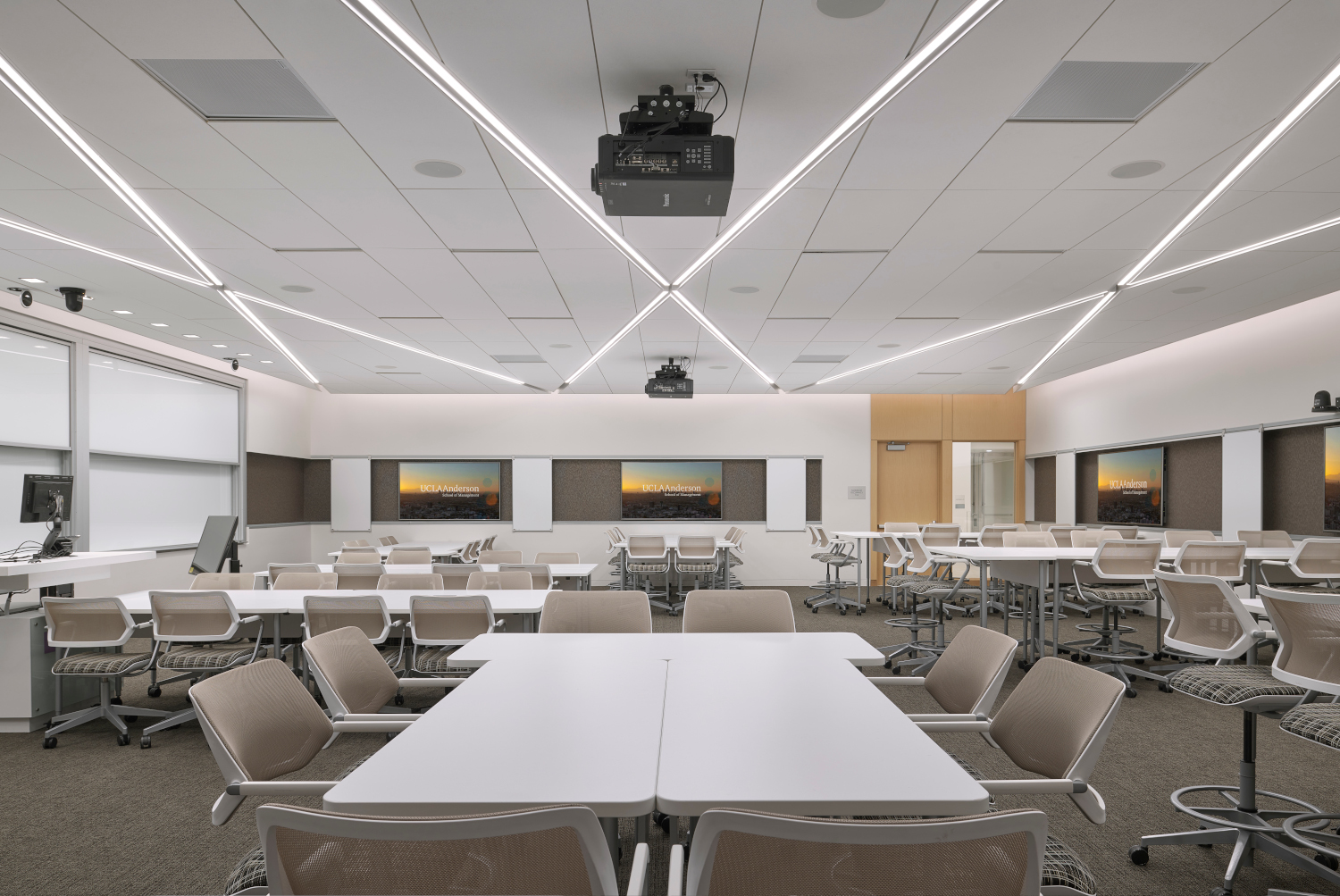
Hidden AV
There are two lecture halls, which seat 200 and 90 students, respectively. Mediasite software is deployed in both for lecture capture; the larger hall uses several 24-inch square Shure MXA-910 flush-mount ceiling microphone arrays to capture audio while the smaller space uses Audix M70 flush-mount ceiling microphones for that. Both rooms have Panasonic PTZ cameras for video capture.
The event space, also used for lectures, panel discussions and banquets, is an example of how the AV implementation had to conform to the architectural aesthetics. It has perhaps the most striking architectural elements of all: an undulating curved suspension-ceiling product composed of perforated wood with an acoustic backing to achieve the required acoustical absorption, and a massive glass window that makes up the 55’x49′ space’s front wall.
“We had to work closely with Gensler to make sure the AV elements were well hidden,” Di Santo said. For example, he points to the use of Da-Lite’s Wireline screens, which both drop down from a 25-foot ceiling on thin cables that are mostly invisible from the seating area. “That way, we don’t have the black drop at the top of the screen,” he said. The cavernous space could have benefitted from distributed sound, but the ceiling design would not permit the use of surface-mount or ceiling speakers. Instead, a pair of Tannoy Qflex 48 digitally steerable columnar arrays was installed on the front wall. These are preprogrammed, via DSP, to steer differently according to whether the pull-out bleacher-type seating or banquet tables are being used.
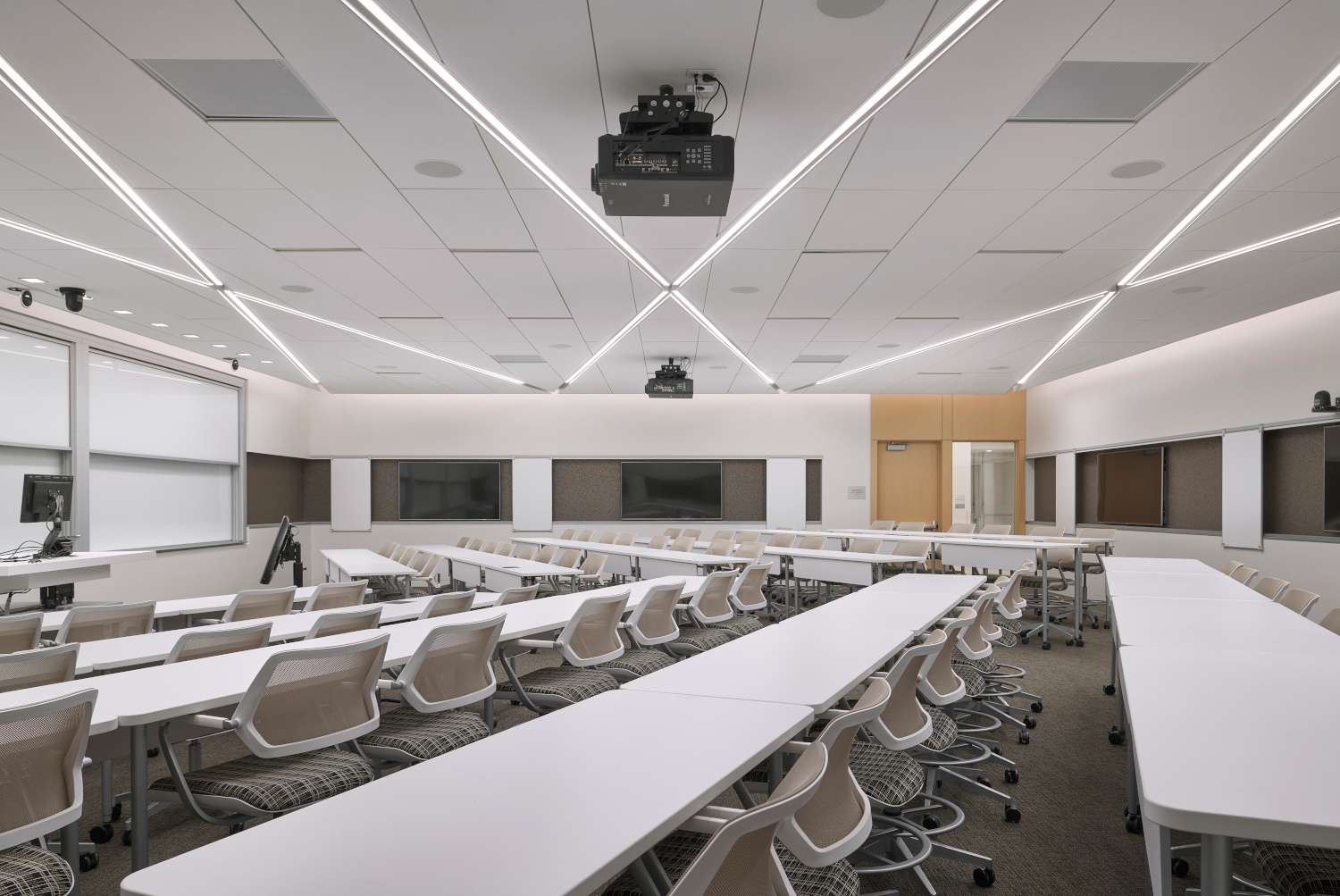
“This required close collaboration with our acoustical designer as well as with the architect in order to find a sound system solution that would cover the entire room and provide the desired intelligibility,” Gales said. “The architect had a very strong vision of the architectural significance of the space, which is reflected in the spectacular ceiling design and the beautiful view of the campus through the glass wall at the front of the room. We had to work though issues around where equipment could be placed.” That included the Digital Projection M-Vision 18K projectors, one of which is mounted on a Draper SLX series motorized drop-down lift located outside the perimeter of the undulated ceiling.
The cherry on top here is a central lobby, located at the apex of a visually stunning stairway, which acts as a welcome center for the school, a gathering point for events, and as a donor celebration. It’s fitted with a Primeview 3×4-configured videowall of 49-inch narrow-bezel LED displays that uses a tvONE processor. Di Santo said this space is an example of how large projects like this traverse the development arc of AV technology, with products and technologies often emerging at the end of a project that weren’t available during the planning phase. “When we were designing it, we presented direct-view LED as a solution but the cost was still kind of high,” he explained. “Of course, as time marched on, it became more affordable, but you don’t usually get to change when you’re a year out and the project has gone out to bid. But the videowall we did does look great.”
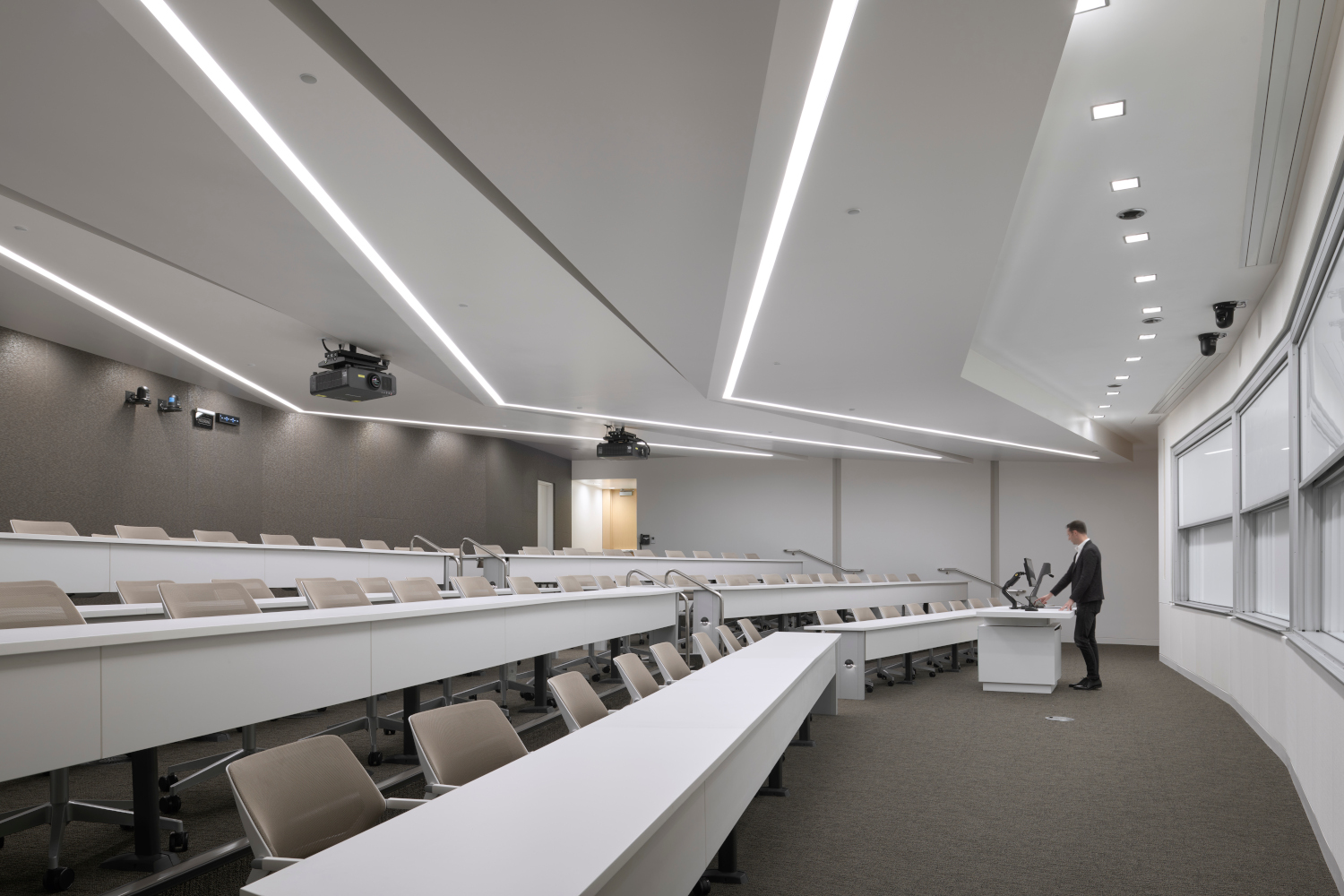
Importance Of Close Coordination
The Marion Anderson Hall project represents another sort of inflection point for AV systems design and integration. “I wish I could tell you about how we lowered a skinny integrator into a narrow space so he could terminate a connection in there, but that’s not what this project was about,” according to Lee Haffely, account manager for Spinitar. The AV integrator is continuing a 20-plus-year-long relationship with both UCLA and the Anderson Graduate School of Management. During that time, Spinitar introduced the Crestron NVX platform to the institution, and worked with the university’s IT team to connect the graduate school building with Korn Hall, the university’s world-class lecture and event space (part of a long-range initiative called “Classroom Number Next”). Instead of working as a siloed entity within the project’s scope, he said, Spinitar coordinated closely with consultant Waveguide, general contractor PCL and the school’s IT department. That collaboration, he said, brought the project in on time, within budget and with virtually no deviations from its timeline. “Literally, the only change orders in the entire project were some cooling fans in the lecterns,” Haffely, a former Boeing project manager, said. “I’ve learned to depend on general contractors, electrical contractors, the consultants and the enablers to be able to bring projects together like this. We look at timelines, budget, and as importantly, risk analysis, which is something I learned during my time at Boeing—how to predict where the problems might be and how to avoid them.”
That was what was behind Spinitar’s initiative to build mock-ups of all the major racked systems that would go into Anderson Hall, which were built and tested inside the integrator’s own offices in La Mirada, in California’s Orange County. “The difference between the teaching spaces in the new Anderson Hall versus the existing building [where Spinitar is also responsible for the AV updates] is the size of the classrooms themselves,” Haffely said. “In the new facility, the classrooms are either smaller or much larger than the conventional 60-seat ones seating as many as 150-plus students, who can reconfigure around their desks, which enhances their ability to collaborate. It’s very much a physical change that we’ve adapted the AV around; for instance, using large-format video projection to make sure everyone can see all of the content on screens. Also, we built in the ability to record and multicast content, and use Zoom as a virtual classroom, which can come in very handy at the moment. Waveguide was very thoughtful about how they scaled the video solutions for this kind of room.”
Nevertheless, there were plenty of traditional sorts of integration tasks on the project, such as cabling. Haffely said they handled all of the project’s prewiring, including copper cable in the classrooms, as well as connecting the business school to Korn Hall across campus via fiber, part of an earlier project. “We put our cables into the GC’s conduit, as well as installing all of the hardware, such as projectors, screens and speakers, plus all of the racks and hundreds and hundreds of NVX nodes throughout the building,” he said. “We also did the programming on the Crestron DGE graphical software,” which combines advanced controls for AV, lighting, shades, HVAC, security and other functions. The graphical software also controls dual-window video displays that are deployed on the instructors’ lecterns, as well as annotation, audio feedback, and web browsing, which Haffely said was programmed to be visible on the instructors’ screens but not the students’ toolbar displays, to avoid distractions. All of this rides on a 40GB backbone, up from the 25GB initially projected. “Because of our decades-long relationship with UCLA and Waveguide, we were able to get all of this done right and on time because we all worked together and planned it out,” he said. “There’s no other way to do this.”
Education, like all major AV verticals, will face considerable challenges in coming months. Enrollments, already declining since the end of the 2008 recession, could be further depressed by another one precipitated by the pandemic. Audio and video technology will offer a strategic tool for colleges and universities that are about to face the most significant competitive landscape for higher education in more than a decade.
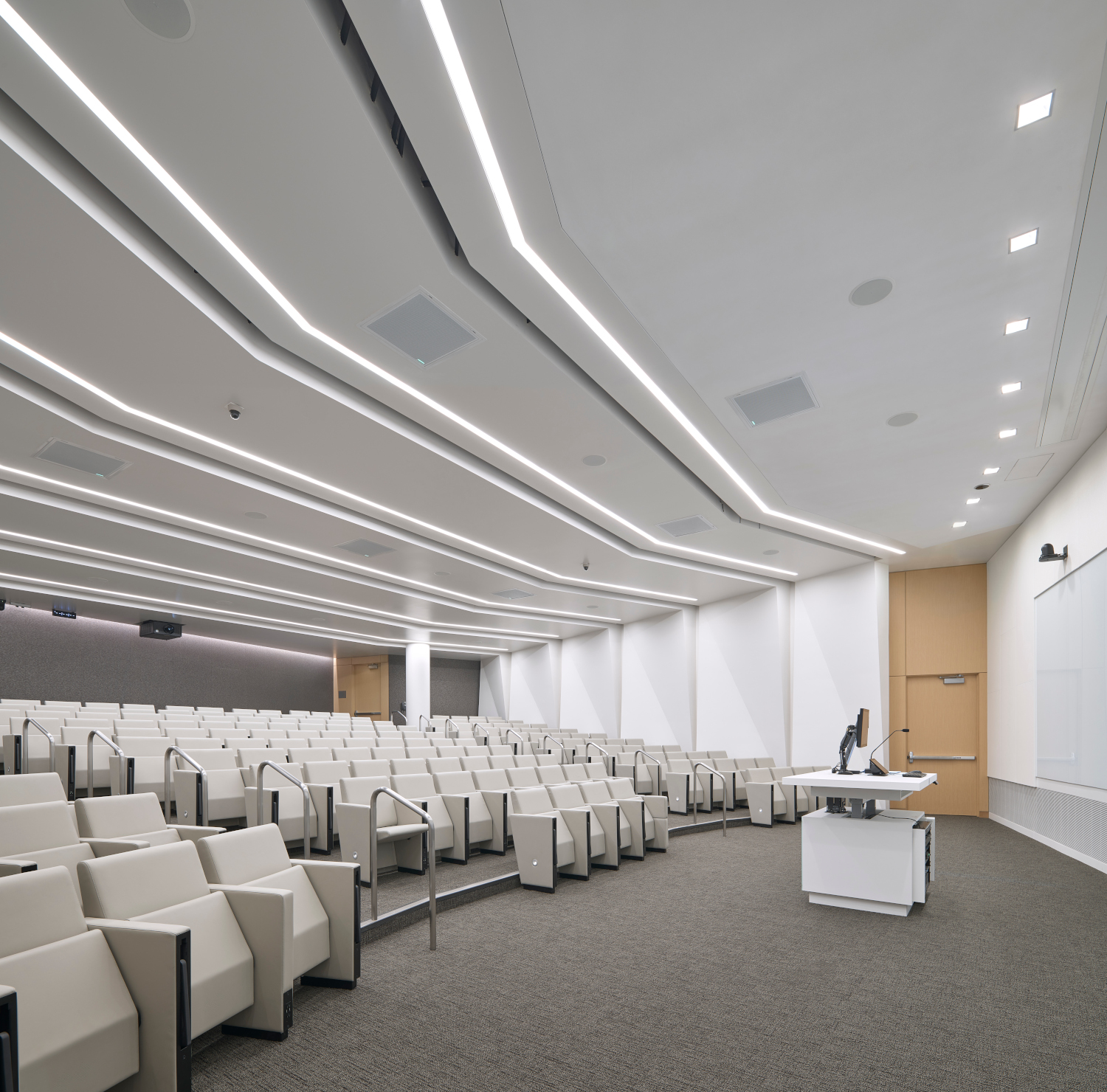
Endnotes
1 https://blogs.loc.gov/inside_adams/2019/01/when-a-quote-is-not-exactly-a-quote-the-business-of-america-is-business-edition
2 https://www.insidehighered.com/quicktakes/2019/05/30/college-enrollment-declines-continue
3 https://blogs.anderson.ucla.edu/anderson/2018/05/ucla-anderson-eagerly-awaits-marion-anderson-hall.html
For more installation features from Sound & Communications, click here.